“Blessed is the face of Sai. If we cast a glance at Him for a moment, He destroys the sorrow of many past births and confers great bliss on us; and if He looks at us with grace, our bondage of Karma is immediately snapped away, and we are led to happiness.” – Satcharitra
Sai Baba, one of the foremost spiritual masters of India, lived in Shirdi for 60 years, transforming it into a great spiritual center. Shirdi, located in Maharashtra, India, became a place of divine wisdom and universal love due to Baba's presence.
Sai Baba never sought publicity, nor did he tour or give discourses. Yet, his radiant spiritual energy attracted countless devotees, transcending barriers of caste, creed, and religion. He took Samadhi in 1918, leaving behind a legacy of faith, devotion, and universal brotherhood. His teachings emphasized unity, compassion, and selfless service. Baba's message was simple: all religions are one, and the divine resides in every being. He led by example, guiding his devotees through direct experiences rather than mere words.
For those new to Sai Baba's teachings, we encourage you to explore the Sai Satcharitra, a sacred text that encapsulates the wisdom and miracles of this great saint.
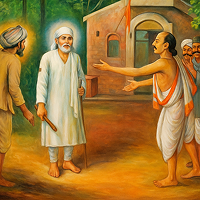
The birth and the early life of Shri Saibaba are not much known. From the year 1858, Baba lived in the village of Shirdi in the state of Maharashtra for over sixty years. Baba came to Shirdi in 1858 accompanying a wedding procession as guest of honor. He was greeted by Mahalsapathi “Ya – Sai”(Welcome Sai). Baba accepted that name to be eternally his and spent his early days at Shirdi, under a neem tree and later lived in the masjid which he named as Dwarkamai or Mother Dwarka.
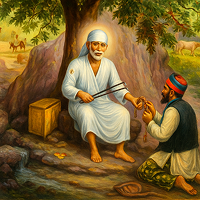
Chand Patil was once riding through the forest when suddenly he felt an acute urge to smoke. To his great dismay, however, he found that he did not have the wherewithal to ignite a fire to light his chelum with. Seeing Sai Baba seated under a tree, the rider approached him for a match. Baba had no matches, but just by thrusting the tongs nearly, he produced flames. The rider witnessing the miracle, realizes Baba’s divine stature and kneels to him in devotion .
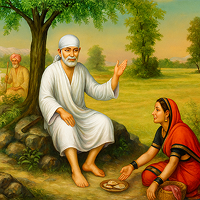
Here is an instance of a devotee’s burning love for the master. Baijabai daily sought out Baba in the forest where he lived in the early days, in order to bring him food, which she lovingly prepared for him. Baba raises his hand in a gesture of blessing.
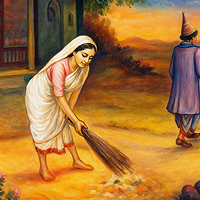
Service is the badge of God’s kingdom. Radha Krishna Mai voluntarily assumed the duty of sweeping the ashram compound daily. This was her way of showing her adoration for the Master.
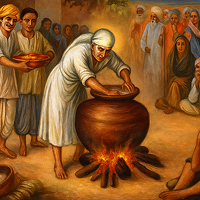
Saibaba was the common man’s God. He lived with them; he slept and ate with them. He had no pretensions of any kind. Baba used to feed the fakirs and devotees and even cook for them. The food that Baba made seemed to grow in abundance and there was always enough for everyone. The touch of a Sat-Purusha unlocks the storehouse of the Goddess Annapoorna’s unlimited resources.
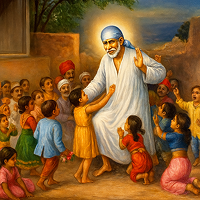
Saibaba was very fond of children. He used to spend part of his day in playing, chit-chatting or humoring with the children of the village.